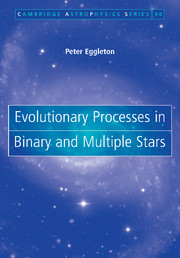Book contents
- Frontmatter
- Contents
- Preface
- 1 Introduction
- 2 Evolution of single stars
- 3 Binary interaction: conservative processes
- 4 Slow non-conservative processes
- 5 Rapid non-conservative processes
- 6 Accretion by the companion
- Appendix A The equations of stellar structure
- Appendix B Distortion and circulation in a non-spherical star
- Appendix C Perturbations to Keplerian orbits
- Appendix D Steady, axisymmetric magnetic winds
- Appendix E Stellar dynamos
- Appendix F Steady, axisymmetric, cool accretion discs
- References
- Subject index
- Stellar objects index
1 - Introduction
Published online by Cambridge University Press: 17 August 2009
- Frontmatter
- Contents
- Preface
- 1 Introduction
- 2 Evolution of single stars
- 3 Binary interaction: conservative processes
- 4 Slow non-conservative processes
- 5 Rapid non-conservative processes
- 6 Accretion by the companion
- Appendix A The equations of stellar structure
- Appendix B Distortion and circulation in a non-spherical star
- Appendix C Perturbations to Keplerian orbits
- Appendix D Steady, axisymmetric magnetic winds
- Appendix E Stellar dynamos
- Appendix F Steady, axisymmetric, cool accretion discs
- References
- Subject index
- Stellar objects index
Summary
Background
Because gravity is a long-range force, it is difficult to define precisely the concept of an ‘isolated star’ – and consequently also the concept of a binary or triple star. Nevertheless, many stars are found whose closest neighbouring star is a hundred, a thousand or even a million times closer than the average separation among stars in the general neighbourhood. Such pairings of stars are expected to be very long lived. There also exist occasional local clusterings of perhaps a thousand to a million stars, occupying a volume of space which would much more typically contain only a handful of stars. These clusters can also be expected to be long lived – although not as long lived as an ‘isolated’ binary, since the combined motion of stars in a large cluster causes a slow evaporation of the less massive members of the cluster, which gain kinetic energy on average from close gravitational encounters with the more massive members. Intermediate between binaries and clusters are to be found small multiple systems containing three to six members, and loose associations containing somewhat larger numbers. Starting from the other end, some clusters may contain sub-clusters, and perhaps sub-sub-clusters, down to the scale of binaries and triples.
Even with the naked eye, a handful of the 5000 stars visible can be seen to be double; and in the northern hemisphere two clusters of stars, the Hyades and the Pleiades, are quite recognisable.
- Type
- Chapter
- Information
- Evolutionary Processes in Binary and Multiple Stars , pp. 1 - 30Publisher: Cambridge University PressPrint publication year: 2006

